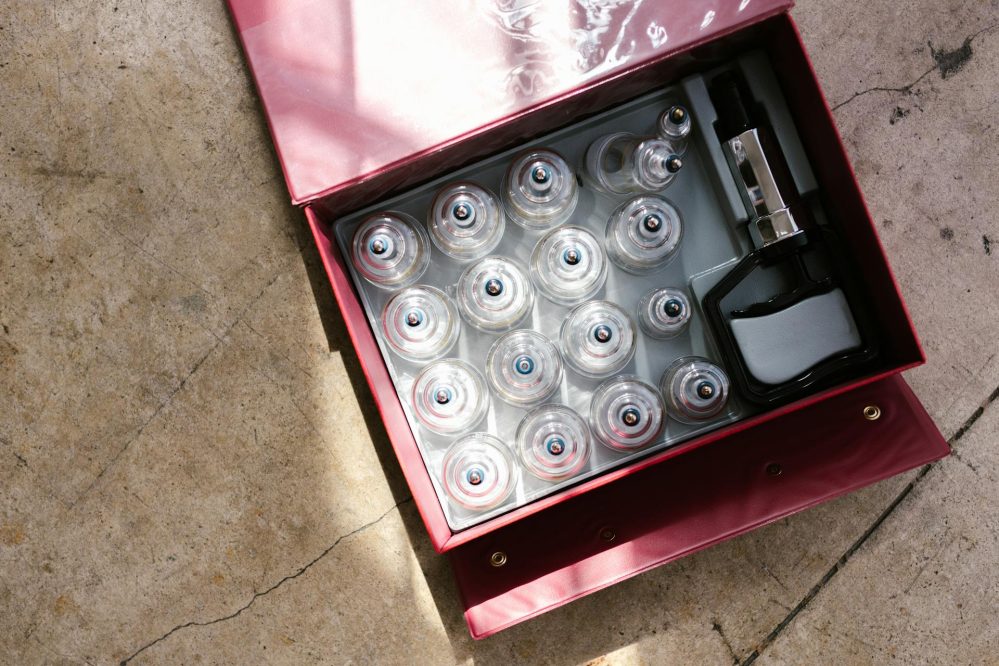Key Takeaways
— Facial cupping is a natural treatment that improves blood flow, reduces puffiness, and makes your skin glow.
— The skin is gently pulled by tiny cups, stimulating blood flow and eliminating excess fluid.
— Facial cupping not only firms the skin and minimizes wrinkles but also relaxes muscles and alleviates sinus issues.
— To ensure facial cupping is safe and effective, apply gentle suction and follow proper guidelines.
Facial cupping is a natural skincare technique that improves circulation, leaving the skin radiant and healthy. With roots in various ancient civilizations, this practice has been used for centuries to enhance overall well-being. Today, its effectiveness in enhancing skin tone, reducing puffiness, and encouraging collagen production has made it increasingly popular in the cosmetic industry.
In this article, we’ll examine the advantages, potential risks, and professional tips for making the most of facial cupping.
What Is Facial Cupping?
Facial cupping is a soothing skincare technique that uses small silicone or glass cups to create gentle suction on the skin. This process makes the skin firmer and healthier by increasing blood circulation, reducing fluid retention, and boosting collagen production.
Unlike body cupping, which involves stronger suction to relieve muscle tension, improve circulation, and aid detoxification — often leaving markings on the skin — facial cupping is much gentler and doesn’t cause bruises. To relax facial muscles and revitalize the skin, the cups are either gently glided across the face or briefly applied to specific areas.
For thousands of years, cupping therapy has been an integral part of traditional Chinese, Egyptian, and Middle Eastern medicine, supporting healing and overall wellness. In skincare, facial cupping has long been valued for its ability to enhance skin tone, boost circulation, and reduce puffiness. Today, it has become a popular natural beauty treatment, recognized for its rejuvenating effects.
How Does Facial Cupping Work?
Using tiny silicone or glass cups, facial cupping creates gentle suction on the skin to increase blood flow, enhance lymphatic drainage, and stimulate collagen production. The process begins with applying a light layer of oil to help the cups glide smoothly. Next, the cups are placed on the face and either moved upward or held in place for a few seconds before being released.
For beginners, silicone cups are perfect since they are pliable and soft, while glass cups often have a tiny pump for better suction control. By drawing oxygen-rich blood to the skin’s surface, this technique reduces puffiness, relaxes facial muscles, and leaves the skin looking radiant and refreshed.
A typical session lasts about 5 to 15 minutes and can be done two to three times per week for the best results. While at-home treatments are convenient and affordable, for individuals seeking noticeable results, professional sessions provide expert techniques and enhanced benefits.
Benefits of Facial Cupping

Facial cupping offers numerous benefits for both your skin and overall well-being. It helps improve facial health, encourage relaxation, and achieve a more radiant complexion. Many individuals find that it helps relieve facial tension and rejuvenates their skin. In the following sections, we’ll take a closer look at how facial cupping can improve your skin and general wellness.
Skin benefits
Facial cupping is a fantastic addition to any skincare routine because of its many benefits. It improves blood circulation, delivering more nutrients and oxygen to the skin for a vibrant, glowing appearance. The gentle suction helps reduce puffiness and swelling, especially around the eyes, by eliminating excess fluid.
With consistent use, facial cupping stimulates collagen production, which is necessary for maintaining skin firmness, elasticity, and smoothness. As a result, this technique can minimize fine lines and wrinkles, enhancing a youthful appearance. Additionally, facial cupping enhances the absorption of skincare products, including serums and moisturizers, ensuring better hydration and nourishment for long-lasting skin health.
Health and wellness benefits

Facial cupping is not just good for the skin — it also has many benefits for overall health and well-being. One of its main benefits is alleviating tightness in facial muscles caused by stress or regular facial expressions. The gentle suction helps relax areas of tension around the eyes, forehead, and jaw.
Facial cupping also promotes lymphatic drainage, reducing puffiness and boosting circulation by helping the body remove excess fluid. This process can help relieve pressure and clear nasal passages, which can be especially helpful for people with sinus congestion. Frequent face cupping has been shown to help those with circulation issues or tension headaches as well.
Is Facial Cupping Safe? Potential Side Effects and Risks
When done correctly, facial cupping is generally safe, though some mild side effects may occur. Common reactions include mild swelling, moderate redness, or temporary bruises, especially if the suction is excessively strong or the cups are placed in one place for too long.
Individuals with sensitive skin conditions such as rosacea, eczema, or active acne should avoid facial cupping, as it may cause irritation. People with clotting disorders or extremely thin skin should consult a dermatologist before trying it.
To minimize these risks, it’s essential that you use the right techniques, such as applying gentle suction, moving the cups upward, and avoiding prolonged suction on one spot. If you do end up experiencing any discomfort or irritation, it’s advisable to stop and consult a skincare professional.
How to Do Facial Cupping at Home

For a safe and effective at-home facial cupping session, choose tiny silicone or plastic cups specifically designed for delicate facial skin. These are softer and more flexible than the larger cups used for body cupping, making them ideal for gentle suction.
Start by cleansing your face to remove any dirt, oil, or makeup residue. Next, apply a light layer of face oil or serum to ensure the cups glide smoothly over the skin without causing any discomfort.
To create suction, gently squeeze the cup, place it on your skin, and slowly release it. Move the cup in small, upward strokes along your jawline, cheeks, forehead, and under-eye area, but be careful to avoid sensitive spots like the eyelids. Always keep the cups in motion to prevent bruising, and never use them on broken or irritated skin. Also, avoid leaving a cup in one spot for too long, as it could cause marks or irritation.
A session should last around 5 to 10 minutes. This is enough time to improve blood flow and revitalize your skin without overdoing it.
Expert Tips for Maximizing Facial Cupping Results
To get the best results from facial cupping, it’s important to incorporate it into a well-rounded skincare routine. Pair it with nourishing products like hydrating serums, anti-aging creams, or oils enriched with ingredients such as vitamin C, hyaluronic acid, or peptides. These formulations complement cupping by enhancing skin hydration, elasticity, and overall radiance.
The ideal time for facial cupping is in the evening, as this allows your skin to rest and absorb the benefits overnight. However, a morning session can also be beneficial, as it stimulates circulation and refreshes your complexion for the day ahead.
For optimal results, practice facial cupping regularly — about two to three times a week — and follow up with a quality moisturizer to maintain hydration. Make sure to use gentle suction and avoid excessive treatments, as consistency is important for seeing long-term improvements. When combined with a proper skincare regimen that includes cleansing, exfoliating, and moisturizing, facial cupping can significantly improve your skin’s appearance and health.
The Bottom Line
Facial cupping offers numerous benefits, from improved circulation and reduced puffiness to enhanced skin elasticity and a youthful appearance. Additionally, it helps ease facial tension and promote overall relaxation. Whether you try it at home with gentle techniques or seek a professional for advanced treatments, facial cupping can be a valuable addition to your skincare routine.
For long-term benefits, consistency is key. Pair facial cupping with nourishing skincare products, and always follow proper techniques to ensure both safety and effectiveness.
Interested in expanding your knowledge in healthcare? Explore AIAM’s diverse programs and discover how they can support your career growth. Check them out today!
Frequently Asked Questions (FAQs)
How often should you do facial cupping?
For optimal results, facial cupping should be done 2-3 times a week.
Is facial cupping or gua sha better?
Both techniques offer benefits, but facial cupping is particularly effective for boosting circulation and promoting lymphatic drainage, while gua sha is great for relieving muscle tension and sculpting the face.
What not to do after facial cupping?
After a session, avoid direct sun exposure and harsh skincare treatments to prevent irritation and protect the skin.
How long does it take to see results from facial cupping?
Some improvements may be noticeable after a few sessions, with more significant enhancements in skin tone and texture typically appearing within 2–3 weeks of consistent use. Long-term collagen support can take several months.